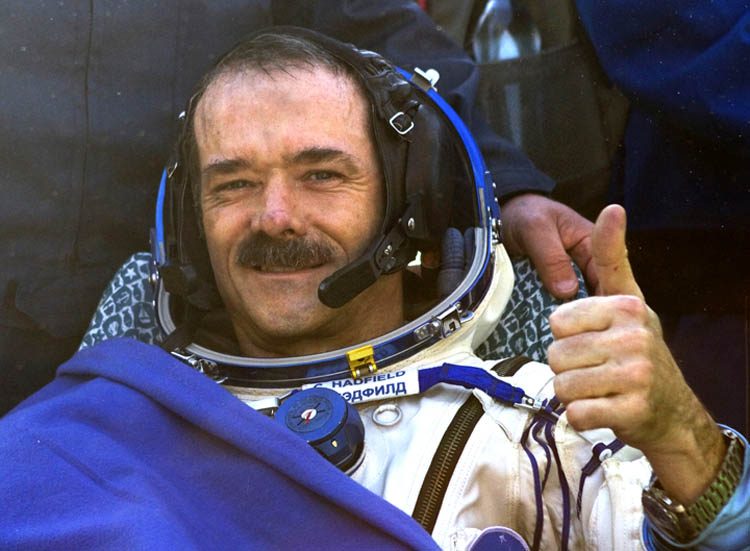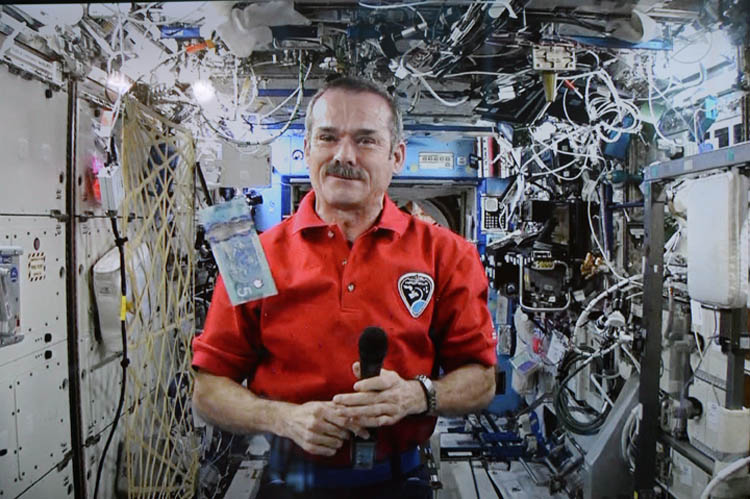Ground control to Major Chris
Hadfield shows how to be down to earth in outer space
Advertisement
Read this article for free:
or
Already have an account? Log in here »
To continue reading, please subscribe:
Monthly Digital Subscription
$19 $0 for the first 4 weeks*
- Enjoy unlimited reading on winnipegfreepress.com
- Read the E-Edition, our digital replica newspaper
- Access News Break, our award-winning app
- Play interactive puzzles
*No charge for 4 weeks then billed as $19 every four weeks (new subscribers and qualified returning subscribers only). Cancel anytime.
Read unlimited articles for free today:
or
Already have an account? Log in here »
Hey there, time traveller!
This article was published 24/05/2013 (3989 days ago), so information in it may no longer be current.
It’s been a spacey month in pop culture.
The obvious big event was Star Trek Into Darkness, a 3D extravaganza involving exploding lava, warp-speed chases, hot alien girls with tails and Benedict Cumberbatch’s bone structure.
But the unexpected big event was Canadian astronaut Chris Hadfield’s extraterrestrial version of David Bowie’s Space Oddity.

Star Trek has spectacle and special effects and grand scale and general CGI whizzbangery. But for me, it was Hadfield’s little five-minute music video that really won the space race. Something about its realness, its modesty and its straight-up emotional connection was profoundly moving.
Since starting his stint as commander of the International Space Station in December 2012, Hadfield has been using the power of social media to make space cool again. Our very own Rocket Man, the 53-year-old Sarnia-born astronaut with the adorably unhip Tom Selleck ‘stache has nearly one million Twitter followers. His YouTube videos, in which he chats about space stuff and does Q&A’s with the folks back home, have drawn massive audiences.
In what is probably the zenith of Canuck space geekdom, Hadfield took part in a live Earth-to-space-station conversation with William Shatner, the one-time Captain James T. Kirk.
And on top of all that astro-outreach, near the end of his five-month mission Hadfield did the Bowie music video that the science blog i09 calls “the most epic cover of Space Oddity in the history of everything.”
So far the vid has snagged over 14 million views, signalling not just new public attention but a shift in public attitude. Somehow, seeing Hadfield singing his heart out on the ISS has generated a sense of optimism and enthusiasm about the space program that hasn’t been felt much since the early Apollo days.
Hadfield is a musician — he’s a member of an all-astronaut band here on Earth — so his vocals and zero-gravity guitar work are good. But what’s really poignant about the performance is its realness. This is the first music video filmed in space. Hadfield is floating in a tin can. Planet Earth is blue — and it’s right outside the window. There’s an immediate connection between the setting and the song — though Hadfield has (understandably) modified the lyrics for a happier ending.
What’s even better is that the realness is so recognizable. Movies like Star Trek, with their seamless special effects, allow us to imagine all sorts of out-of-this-world possibilities for space travel. Hadfield’s transmissions reveal something a lot less flashy. Contrary to most sci-fi films, which imagine spacecrafts as hyper-designed marvels of sleek white surfaces and techno-futurist minimalism, the ISS looks like a messy college dorm.
There are funny posters with peeled edges that say “Speed Limit 28,000 km/h.” (Astronaut joke!). There’s lots of clutter, with things held in place by velcro and bits of duct tape, and wires and cords everywhere.

And then there’s Hadfield himself, who seems to be upending those Right Stuff, alpha-male astronaut stereotypes that we know from the movies. He is, of course, super-competent and cool under pressure. (He was top gun at the United States Air Force’s test pilot school, and his list of credentials is endless.) But in his social media campaign, he has an approachable regular-guy demeanour. Maybe it’s because he’s Canadian.
Hadfield is also a relentless demystifier. Instead of making space seem remote, he makes it accessible. His short, friendly videos show us things like how to make a peanut butter and honey sandwich in space. (You can’t use bread because the crumbs would float away.) He talks frankly about issues that are spacey but also very ordinary, like the odd practical challenges involved in sleeping and crying and shaving and throwing up in zero-gravity.
He does neat demonstrations. One of his most popular videos shows him wringing out a wet hand towel; in zero gravity, the surface tension does this wild thing with the water. And I’m sorry, but for sheer awesomeness, Star Trek and all its cold-fusion bombs and transwarp beaming have nothing on this simple science experiment, which was actually conceived by two high school students from Fall River, N.S.
Hadfield is a professional, but he’s also comes across as a keener, a kid, a bit of a rubbernecking space tourist who just can’t believe his luck to be orbiting Earth. When he tweets photographs of night cities glowing like strings of holiday lights or the Australian Outback stretched out like some gorgeous abstract painting, his sense of wonder is contagious.
The Star Trek reboot takes us to faraway galaxies and the distant future. But Hadfield singing Bowie shows us space exploration right here and right now — and somehow that says a lot more about the potential of human ingenuity and the power of the universe than the biggest sci-fi blockbuster ever could.
alison.gillmor@freepress.mb.ca

Alison Gillmor
Writer
Studying at the University of Winnipeg and later Toronto’s York University, Alison Gillmor planned to become an art historian. She ended up catching the journalism bug when she started as visual arts reviewer at the Winnipeg Free Press in 1992.


